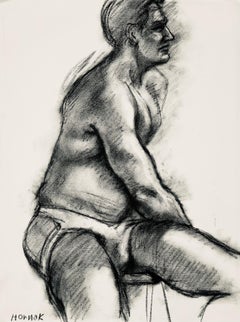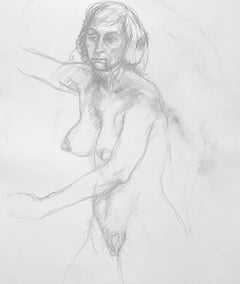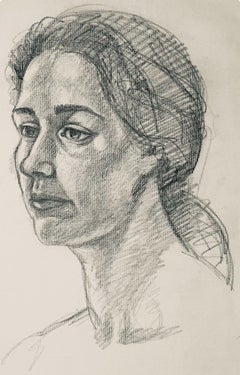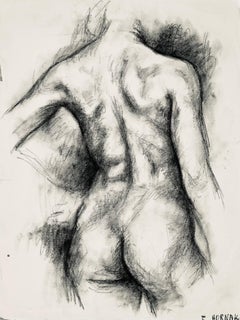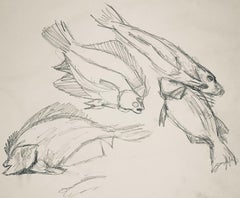Renaissance Nude Drawings and Watercolors
to
85
1
85
Overall Width
to
Overall Height
to
86
85
688
623
121
92
62
57
43
27
21
20
14
12
10
70
15
85
83
42
37
35
30
10
4
2
1
1
1
1
69
17
16
4
4
85
85
1
Style: Renaissance
Renaissance Male Nude Figure Study, 1964, Ian Hornak — Drawing
By Ian Hornak
Located in Fairfield, CT
Artist: Ian Hornak (1944-2002)
Title: Renaissance Male Nude Figure Study
Year: circa 1964
Medium: Original drawing on vélin paper
Size: 23 x 18 inches
Condition: Good
Provenance: Est...
Category
1960s Renaissance Nude Drawings and Watercolors
Materials
Charcoal
$1,880 Sale Price
20% Off
Renaissance Female Nude Figure Study, 1963, Ian Hornak — Drawing
By Ian Hornak
Located in Fairfield, CT
Artist: Ian Hornak (1944-2002)
Title: Renaissance Female Nude Study
Year: circa 1963
Medium: Original drawing on vélin Strathmore paper
Size: 23 x 18 inches
Condition: Good
Provenanc...
Category
1960s Renaissance Nude Drawings and Watercolors
Materials
Graphite
$1,880 Sale Price
20% Off
Renaissance Female Figure Study, 1964, Ian Hornak — Drawing
By Ian Hornak
Located in Fairfield, CT
Artist: Ian Hornak (1944-2002)
Title: Renaissance Female Figure Study
Year: circa 1964
Medium: Charcoal on vélin paper
Size: 23 x 28 inches
Condition: Good
Provenance: Estate of Ian ...
Category
1960s Renaissance Nude Drawings and Watercolors
Materials
Charcoal
$2,200 Sale Price
20% Off
Renaissance Female Nude Figure Study, 1964, Ian Hornak — Drawing
By Ian Hornak
Located in Fairfield, CT
Artist: Ian Hornak (1944-2002)
Title: Renaissance Female Nude Figure Study
Year: circa 1964
Medium: Original drawing on vélin paper
Size: 18 x 23 inches
Condition: Good
Provenance: E...
Category
1960s Renaissance Nude Drawings and Watercolors
Materials
Charcoal
$1,880 Sale Price
20% Off
Renaissance Fish Study, 1963, Ian Hornak — Drawing
By Ian Hornak
Located in Fairfield, CT
Artist: Ian Hornak (1944-2002)
Title: Renaissance Fish Study
Year: circa 1963
Medium: Original drawing on vélin paper
Size: 18 x 23 inches
Condition: Good
Provenance: Estate of Ian H...
Category
1960s Renaissance Nude Drawings and Watercolors
Materials
Charcoal
$1,560 Sale Price
20% Off
Renaissance Female Nude Figure Study, 1964, Ian Hornak — Drawing
By Ian Hornak
Located in Fairfield, CT
Artist: Ian Hornak (1944-2002)
Title: Renaissance Female Nude Figure Study
Year: circa 1964
Medium: Charcoal on vélin paper
Size: 23 x 18 inches
Condition: Good
Provenance: Estate of...
Category
1960s Renaissance Nude Drawings and Watercolors
Materials
Charcoal
$2,200 Sale Price
20% Off
Renaissance Female Nude Figure Study, 1964, Ian Hornak — Drawing
By Ian Hornak
Located in Fairfield, CT
Artist: Ian Hornak (1944-2002)
Title: Renaissance Female Nude Figure Study
Year: circa 1964
Medium: Charcoal on vélin paper
Size: 18 x 23 inches
Condition: Good
Provenance: Estate of...
Category
1960s Renaissance Nude Drawings and Watercolors
Materials
Charcoal
$2,200 Sale Price
20% Off
Renaissance Male Nude Figure Study, 1963, Ian Hornak — Drawing
By Ian Hornak
Located in Fairfield, CT
Artist: Ian Hornak (1944-2002)
Title: Renaissance Male Nude Figure Study
Year: circa 1963
Medium: Original drawing on vélin Strathmore paper
Size: 23 x 18 inches
Condition: Good
Prov...
Category
1960s Renaissance Nude Drawings and Watercolors
Materials
Graphite
$1,880 Sale Price
20% Off
Renaissance Female Nude Figure Study, 1964, Ian Hornak — Drawing
By Ian Hornak
Located in Fairfield, CT
Artist: Ian Hornak (1944-2002)
Title: Renaissance Female Nude Figure Study
Year: circa 1964
Medium: Charcoal on vélin paper
Size: 18 x 23 inches
Condition: Good
Provenance: Estate of...
Category
1960s Renaissance Nude Drawings and Watercolors
Materials
Charcoal
$1,560 Sale Price
20% Off
Renaissance Female Nude Figure Study, 1963, Ian Hornak — Drawing
By Ian Hornak
Located in Fairfield, CT
Artist: Ian Hornak (1944-2002)
Title: Renaissance Female Nude Study
Year: circa 1963
Medium: Original drawing on vélin Strathmore paper
Size: 23 x 18 inches
Condition: Good
Provenanc...
Category
1960s Renaissance Nude Drawings and Watercolors
Materials
Graphite
$1,880 Sale Price
20% Off
Renaissance Male Hand Figure Study, 1964, Ian Hornak — Drawing
By Ian Hornak
Located in Fairfield, CT
Artist: Ian Hornak (1944-2002)
Title: Renaissance Male Nude Figure Study
Year: circa 1964
Medium: Original drawing on vélin paper
Size: 18 x 23 inches
Condition: Good
Provenance: Est...
Category
1960s Renaissance Nude Drawings and Watercolors
Materials
Charcoal
$1,880 Sale Price
20% Off
Renaissance Female Nude Figure Study, 1964, Ian Hornak — Drawing
By Ian Hornak
Located in Fairfield, CT
Artist: Ian Hornak (1944-2002)
Title: Renaissance Female Nude Figure Study
Year: circa 1964
Medium: Original drawing on vélin paper
Size: 23 x 18 inches
Condition: Good
Provenance: E...
Category
1960s Renaissance Nude Drawings and Watercolors
Materials
Charcoal
$1,880 Sale Price
20% Off
Renaissance Female Nude Figure Study, 1963, Ian Hornak — Drawing
By Ian Hornak
Located in Fairfield, CT
Artist: Ian Hornak (1944-2002)
Title: Renaissance Female Nude Figure Study
Year: circa 1963
Medium: Original drawing on vélin paper
Size: 18 x 23 inches
Condition: Good
Provenance: E...
Category
1960s Renaissance Nude Drawings and Watercolors
Materials
Charcoal
$1,880 Sale Price
20% Off
Renaissance Female Nude Figure Study, 1963, Ian Hornak — Drawing
By Ian Hornak
Located in Fairfield, CT
Artist: Ian Hornak (1944-2002)
Title: Renaissance Female Nude Figure Study
Year: circa 1963
Medium: Original drawing on vélin paper
Size: 23 x 18 inches
Condition: Good
Provenance: E...
Category
1960s Renaissance Nude Drawings and Watercolors
Materials
Charcoal
$1,880 Sale Price
20% Off
Renaissance Female Nude Figure Study, 1963, Ian Hornak — Drawing
By Ian Hornak
Located in Fairfield, CT
Artist: Ian Hornak (1944-2002)
Title: Renaissance Female Nude Figure Study
Year: circa 1963
Medium: Charcoal on vélin paper
Size: 23 x 18 inches
Condition: Good
Provenance: Estate of...
Category
1960s Renaissance Nude Drawings and Watercolors
Materials
Charcoal
$1,880 Sale Price
20% Off
Renaissance Male Figure Study, 1963, Ian Hornak — Drawing
By Ian Hornak
Located in Fairfield, CT
Artist: Ian Hornak (1944-2002)
Title: Renaissance Male Figure Study
Year: circa 1963
Medium: Original drawing on vélin paper
Size: 18 x 23 inches
Condition: Good
Provenance: Estate o...
Category
1960s Renaissance Nude Drawings and Watercolors
Materials
Charcoal
$2,200 Sale Price
20% Off
Renaissance Female Nude Figure Study, 1963, Ian Hornak — Drawing
By Ian Hornak
Located in Fairfield, CT
Artist: Ian Hornak (1944-2002)
Title: Renaissance Female Nude Study
Year: circa 1963
Medium: Original drawing on vélin Strathmore paper
Size: 23 x 18 inches
Condition: Good
Provenanc...
Category
1960s Renaissance Nude Drawings and Watercolors
Materials
Charcoal
$1,880 Sale Price
20% Off
Female Figure Study, 1963, Ian Hornak — Drawing
By Ian Hornak
Located in Fairfield, CT
Artist: Ian Hornak (1944-2002)
Title: Female Figure Study
Year: circa 1963
Medium: Original drawing on vélin paper
Size: 23 x 18 inches
Condition: Good
Provenance: Estate of Ian Horn...
Category
1960s Renaissance Nude Drawings and Watercolors
Materials
Charcoal
$2,200 Sale Price
20% Off
Renaissance Female Nude Figure Study, 1963, Ian Hornak — Drawing
By Ian Hornak
Located in Fairfield, CT
Artist: Ian Hornak (1944-2002)
Title: Renaissance Female Nude Study
Year: circa 1963
Medium: Original drawing on vélin Strathmore paper
Size: 23 x 18 inches
Condition: Good
Provenanc...
Category
1960s Renaissance Nude Drawings and Watercolors
Materials
Graphite
$1,880 Sale Price
20% Off
Renaissance Female Nude Figure Study, 1963, Ian Hornak — Drawing
By Ian Hornak
Located in Fairfield, CT
Artist: Ian Hornak (1944-2002)
Title: Renaissance Female Nude Study
Year: circa 1963
Medium: Original drawing on vélin Strathmore paper
Size: 23 x 18 inches
Condition: Good
Provenanc...
Category
1960s Renaissance Nude Drawings and Watercolors
Materials
Graphite
$1,880 Sale Price
20% Off
Female Figure Study, 1963, Ian Hornak — Drawing
By Ian Hornak
Located in Fairfield, CT
Artist: Ian Hornak (1944-2002)
Title: Female Figure Study
Year: circa 1963
Medium: Original drawing on vélin paper
Size: 23 x 18 inches
Condition: Good
Provenance: Estate of Ian Horn...
Category
1960s Renaissance Nude Drawings and Watercolors
Materials
Charcoal
$2,600 Sale Price
20% Off
Renaissance Female Nude Figure Study, 1963, Ian Hornak — Drawing
By Ian Hornak
Located in Fairfield, CT
Artist: Ian Hornak (1944-2002)
Title: Renaissance Female Nude Figure Study
Year: circa 1963
Medium: Charcoal on vélin paper
Size: 23 x 18 inches
Condition: Good
Provenance: Estate of...
Category
1960s Renaissance Nude Drawings and Watercolors
Materials
Charcoal
$2,200 Sale Price
20% Off
Renaissance Male Nude Figure Study, 1963, Ian Hornak — Drawing
By Ian Hornak
Located in Fairfield, CT
Artist: Ian Hornak (1944-2002)
Title: Renaissance Male Nude Figure Study
Year: circa 1963
Medium: Original drawing on vélin paper
Size: 23 x 18 inches
Condition: Good
Provenance: Est...
Category
1960s Renaissance Nude Drawings and Watercolors
Materials
Charcoal
$1,560 Sale Price
20% Off
Renaissance Female Nude Figure Study, 1964, Ian Hornak — Drawing
By Ian Hornak
Located in Fairfield, CT
Artist: Ian Hornak (1944-2002)
Title: Renaissance Female Nude Figure Study
Year: circa 1964
Medium: Charcoal on vélin paper
Size: 18 x 23 inches
Condition: Good
Provenance: Estate of...
Category
1960s Renaissance Nude Drawings and Watercolors
Materials
Charcoal
$1,880 Sale Price
20% Off
Renaissance Female Nude Figure Study, 1964, Ian Hornak — Drawing
By Ian Hornak
Located in Fairfield, CT
Artist: Ian Hornak (1944-2002)
Title: Renaissance Female Nude Figure Study
Year: circa 1964
Medium: Original drawing on vélin paper
Size: 23 x 18 inches
Condition: Good
Provenance: E...
Category
1960s Renaissance Nude Drawings and Watercolors
Materials
Charcoal
$1,880 Sale Price
20% Off
Renaissance Female Nude Figure Study, 1963, Ian Hornak — Drawing
By Ian Hornak
Located in Fairfield, CT
Artist: Ian Hornak (1944-2002)
Title: Renaissance Female Nude Figure Study
Year: circa 1963
Medium: Original drawing on vélin paper
Size: 23 x 18 inches
Condition: Good
Provenance: E...
Category
1960s Renaissance Nude Drawings and Watercolors
Materials
Charcoal
$1,880 Sale Price
20% Off
Renaissance nude drawings and watercolors for sale on 1stDibs.
Find a wide variety of authentic Renaissance nude drawings and watercolors available for sale on 1stDibs. Works in this style were very popular during the 20th Century, but contemporary artists have continued to produce works inspired by this movement. Many Pop art paintings were created by popular artists on 1stDibs, including and Ian Hornak. Frequently made by artists working with Paper, and Archival Paper and other materials, all of these pieces for sale are unique and have attracted attention over the years. Not every interior allows for large Renaissance nude drawings and watercolors, so small editions measuring 5 inches across are also available. Prices for nude drawings and watercolors made by famous or emerging artists can differ depending on medium, time period and other attributes. On 1stDibs, the price for these items starts at $844 and tops out at $3,080, while the average work sells for $1,450.
